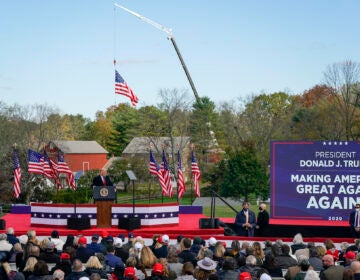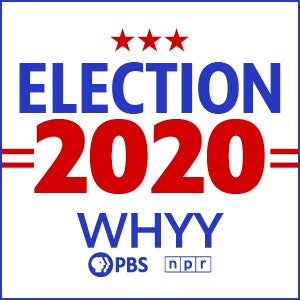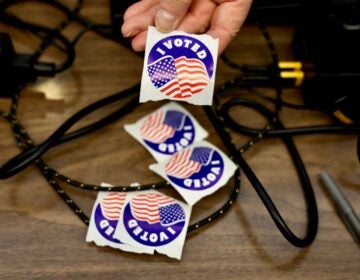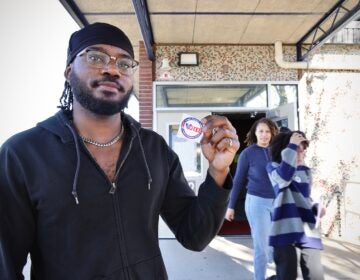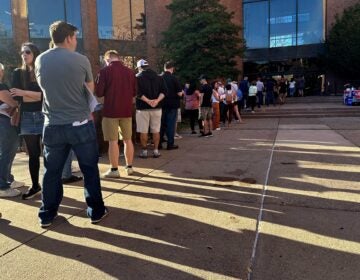Mapping Philly’s most surprising election takeaways
While the historically Democratic city delivered a decisive win for President-elect Joe Biden, a few surprising shifts emerged.
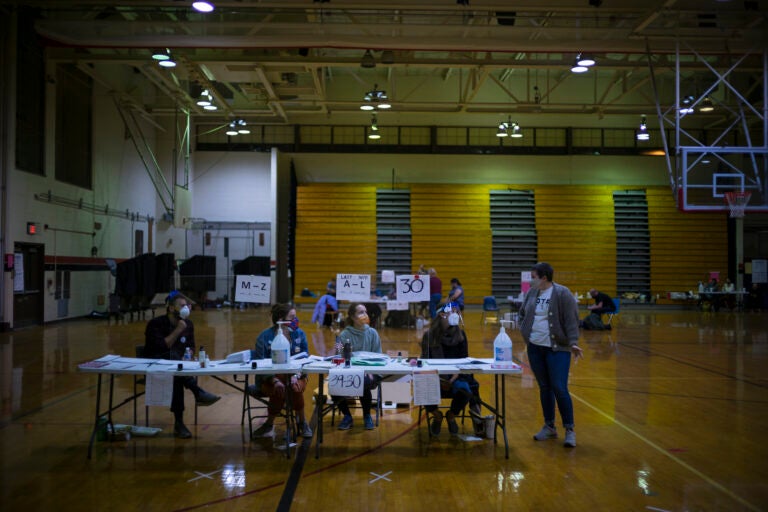
First-time election workers, seated, from left to right, Chris DiStasi, Kaitlin Irvine, Alicia Dlugos and Katie Phillips, end their day at South Philadelphia High School, a polling site on South Broad Street. (Alan Chin for WHYY)
Even as Democrats nationally hailed Philadelphia for helping deliver a decisive win for President-elect Joe Biden in the 2020 presidential election, some in the party locally were left scratching their heads.
In terms of pushing Pennsylvania over the edge, gains in suburban areas were far more decisive. An analysis of ward-level data shows that a predicted surge of Democrats across the city never materialized, while the GOP made small but noticeable gains in many wards.
Here are three takeaways from the city’s election results:
Dem turnout gains were rare
The vast majority of wards saw Democrats’ electoral margins shrink in comparison to 2016. Goals like knocking out the city’s few remaining incumbent Republican elected officials, like state Rep. Martina White, flatlined along with generally flat Democratic turnout.
In some areas, lower turnout may have been unavoidable. University City likely saw Democratic vote declines because of a missing resident student population amid COVID-19. But the larger trend was too widespread to attribute to singular factors, aside from Democrats possibly overestimating Biden’s appeal –– and Trump’s toxicity –– among Black and Latino voters.
Not all areas saw declines. Manayunk, Roxborough, Center City and its surroundings saw Democratic turnout increase by thousands of votes in some instances, with gains that topped nearly 25%.
But nearly as many areas saw little to no change over four years ago.
GOP saw a relative surge in Latino wards
One of the most noticeable trends compared to the 2016 election were rare Republican gains in a city where Dems hold a 7-to-1 registration advantage.
The trend was particularly acute in the city’s majority Latino wards in Juniata or Hunting Park, where Democrat’s margin of victory shrunk by thousands of votes when compared to 2016.
Earlier in the race, Latino elected officials, like Philadelphia Councilmember María Quiñones-Sánchez, warned in October that Democrats were falling short on Latino outreach efforts.
“The national campaigns have always been slow and never invested in the kind of community engagement we’d like to see,” she said.
But while narrower wins in Latino areas were mostly driven by steep declines in Dem turnout versus 2016, places like the 7th Ward also saw growth in Republican votes overall. Here, the party saw 1,003 votes cast over 372 in 2016, increasing some 150%.
The GOP still only won a handful of wards in the city outright –– mostly white, middle-class neighborhoods like Packer Park in South Philly –– but these areas also saw gains from four years ago. Places like Northeast Philly’s 66th Ward, turned out nearly 1,700 more votes for Trump, a 15% increase.
Gains came at expense of third party
Third-party candidates were the biggest loser citywide in 2020. Every ward in the city saw third party and write-in votes decline by anywhere from 40 to 70%.
This partially owes to the fact that there were fewer third party candidates to choose from. The Democrats’ engaged in a legal move for Green Party candidate Howie Hawkins to be pushed off the ballot over procedural issues. Some had also blamed then-Green Party nominee Jill Stein for Hillary Clinton’s loss in 2016.
This legal effort was likely successful in reducing the total number of votes that went to third party candidates. However, as Democrats’ lukewarm performance citywide illustrates, another party’s presence was likely not a major factor in their performance in 2016. Conversely, Libertarian candidate Jo Jorgensen remained on the ballot but seemed to have had little impact on blunting votes for the GOP.
WHYY is your source for fact-based, in-depth journalism and information. As a nonprofit organization, we rely on financial support from readers like you. Please give today.



